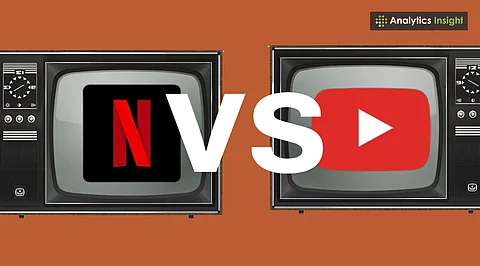

User-led platforms like YouTube are growing due to direct creator-audience engagement.
Authentic, relatable content is driving viewers away from polished studio productions.
Open platforms offer more creative freedom and faster content trends than traditional streaming giants.
The way people consume online content has undergone a significant shift in recent years. Gone are the days when Netflix was the undisputed king of streaming, with its high-end shows and blockbuster movies.
Today, YouTube is outpacing Netflix in terms of audience and popularity. This change isn't accidental; evolving viewer preferences drive it. Audiences now crave personalized content that resonates with them, and YouTube's vast array of relatable and niche content has helped it take the lead.
YouTube and similar sites allow anyone to upload videos. Seriously, there are zero rules. For this reason, many people create videos, ranging from how-to guides and personal vlogs to reviews and live streams. Netflix has its own studio-made content, but what makes YouTube special is that it's full of normal people with unique voices.
The battle of YouTube vs Netflix reflects more profound changes in how people consume and engage with content today. Debates around YouTube vs Netflix often center on creator freedom versus curated storytelling.
YouTube remains the go-to platform for user-generated content and real-time audience feedback. It's like this: anyone can try anything without needing a ton of cash or some company's permission. New ideas pop up fast, which keeps things fresh and exciting.
Also Read: How to Resolve a YouTube Copyright Claim: Step-by-Step Guide
The best thing about YouTube? Anyone can do it! Grab a camera, go online, and boom, you've got a channel. It's so easy that people everywhere can share their stories. Many of these people grow their fan base and turn into internet stars.
Netflix tends to do things the old-fashioned way. They invest a lot of money in fancy shows, which have to go through multiple approvals. It looks great, but it can be tough to be yourself and try new things. These days, people usually want content that feels real and in-the-moment, which is what YouTube is all about.
With constant updates and algorithmic personalization, YouTube stays ahead in platform innovation. Short videos are ruling the Internet these days. These days, who can pay attention for long? YouTube Shorts and other quick video things let creators nail your attention in seconds.
Netflix still offers long shows and movies that require sitting down for hours. When you're moving fast, it's easier to flip on to YouTube and watch something fun or useful while on a break, on the bus, or doing a couple of things at once.
What's cool about places where normal folks post videos is that you can actually talk to the video makers. Comments, likes, live chats – it all makes you feel like you're part of something. It pulls viewers in and makes them feel involved.
Netflix is focusing on original productions to differentiate itself in the increasingly competitive space. You can't really do that on Netflix. You just watch and that is it. On YouTube, it feels more like talking to someone, not listening to a lecture.
YouTube's secret weapon is its video suggestion feature. The site knows your viewing habits and finds things you'll like. It makes it personal, so you keep coming back.
Despite rising Netflix challenges, the platform continues to invest in global storytelling to maintain its edge. Netflix does this too, but it can only choose from what they have. YouTube has an incredible amount of content on pretty much any topic.
This is really simple: YouTube is free. Yeah, you see ads, but you don't need to pay a monthly fee. This is awesome if you're on a tight budget or can't get paid streaming where you live.
Netflix wants you to pay a monthly fee. They've started offering lower-price options with ads, but free remains a massive plus for YouTube and other sites.
Also Read: How to Resume YouTube Music Between Two Devices: A Simple Guide
The reason YouTube is doing so great tells you that we've changed our minds about what we want to see. We want content that's real, not fake, and that has something to do with our lives. Think of lifestyle blogs, gadget reviews, reaction videos, and how-to videos.
These speak to what we're doing every day in a way that often shows just how much we can't. As the Internet evolves, authenticity and relatability are more valuable than elaborate scripts and celebrity endorsements. Every day, video sites are better at giving you just that.
Netflix is still a titan, but you can't ignore the rise of places like YouTube. Regular people are taking over the video world.
It's not just about the tech; it's about the fact that the whole world wants video to be more interactive, personal, and stress-free. As we get into new habits, the future of video might look more like someone filming in their room than a Hollywood set.
Q1. Why are open platforms like YouTube gaining popularity over Netflix?
A1. Open platforms offer relatable content, creative freedom, and interactive features that appeal to modern viewers.
Q2. What makes YouTube more attractive to content creators?
A2. YouTube allows anyone to upload content without high production costs or corporate control.
Q3. How does viewer interaction differ between YouTube and Netflix?
A3. YouTube enables direct communication through comments and live chats, while Netflix offers a passive viewing experience.
Q4. Is cost a major factor in YouTube’s growth?
A4. Yes, YouTube's free access gives it an edge in regions where subscription costs may be a barrier.
Q5. What kind of content performs best on YouTube?
A5. Short-form, real-life, and relatable content tends to perform well and attracts large viewer bases.
